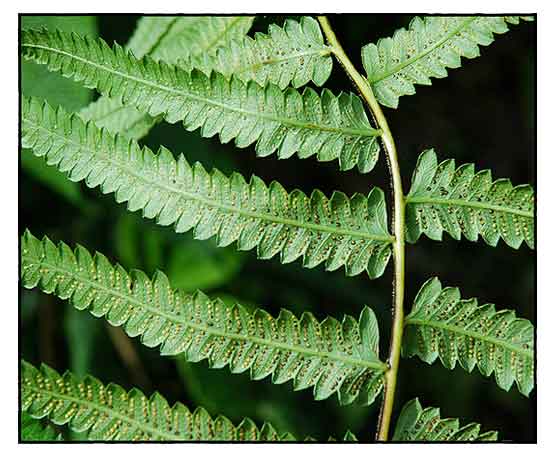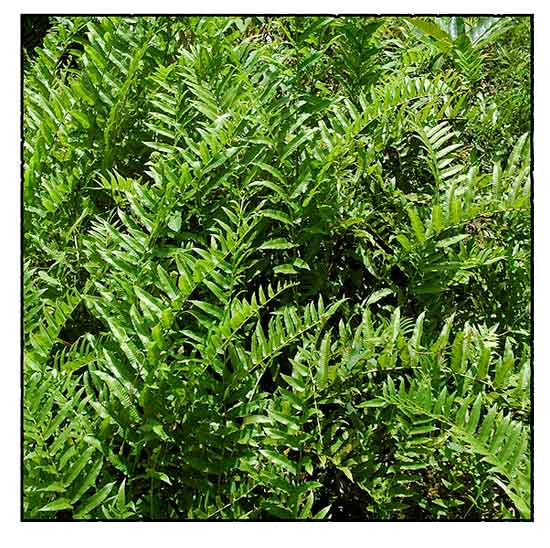 Gen info Gen info
- There is no generally accepted scientific name for the fern and some specialists disagree with the delimitation of the genera within the large family Thelypteridaceae. The species has traveled various genera viz. Cyclosorus, Dryopteris, Meniscium Phegopteris Polypodium, Thelypteris. (2)
-
The family Thelypteridaceae comprises about 1000 species, about 8% of all known ferns. About 430 species are known in Malesia.
- The genus name Thelypteris derives from Greek words thelys "female" and pteris "fern". However, "female fern" usually refers to the common lady-fern. (10)
Botany
A. prolifera is a large, scrambling (2-4 m long), usually sterile fern with proliferous buds scattered along the leaf rachis which develop into new plants. Rhizome short-creeping, 4-10 mm in diameter. Leaves approximate, arching; proliferous buds common in the axils of the pinnae; petiole 12-50 cm long, pale brown, glabrous; lamina narrowly lanceolate to narrowly elliptical, 27-150 cm × 9-26 cm, pinnate, apex indeterminate, papery, both surfaces glabrous; leaves from plants formed by proliferation from buds much smaller, usually with pinna-like terminal lamina; pinnae numerous, the basal pairs distant, the distal ones more closely spaced and smaller, the basal 3-4 pairs gradually reducing in size; rachis with forked hairs or glabrous; midrib above with short hairs, beneath likewise veins very sparsely set with minute hairs, becoming glabrous in older leaves, midrib also bearing a few ovate or peltate, ciliate scales; buds producing long secondary leaves common in the axils of the pinnae; pinnae oblong, 10-15(-20) cm × 1.5-2 cm, sometimes fertile from a size of 3.5 cm × 0.8 cm, base truncate to subcordate, subsessile, the basal lobe often overlapping the rachis, margin crenate, often very shallowly and irregularly so, lobed to a depth of 2 mm, apex acute to acuminate, rather evenly attenuate; secondary veins numerous, 3-4 mm apart, tertiairy veins per pinna lobe up to 12 pairs, 4-7 pairs of anastomosing veins below the shallow sinus uniting alternately to form a zigzag intermediate excurrent vein. Sori circular to elongate, 4-12 on each side of the primary veins, on apical parts of the veins, without indusium, with orange capitate paraphyses, at maturity uniting with adjacent sori. Spores closely and irregularly spinulose. (2)
 Distribution Distribution
- Native to the Philippines.
- Also native to Angola, Assam, Bangladesh, Borneo, Burundi, Cambodia, Cameroon, Central African Repu, China South-Central, China Southeast, East Himalaya, Guinea, Hainan, India, Jawa, Kenya, KwaZulu-Natal, Laos, Lesser Sunda Is., Madagascar, Malawi, Malaya, Maluku, Mauritius, Mozambique, Myanmar, Nepal, New Caledonia, New Guinea, Northern Provinces, Northern Territory, Pakistan, Queensland, Senegal, Sri Lanka, Sulawesi, Sumatera, Taiwan, Tanzania, Thailand, Vietnam, West Himalaya, Western Australia, Zambia, Zaïre, Zimbabwe. (1)
- Widespread throughout the palaeotropics.
- Along water courses and wet grounds in low lands; freshwater swamps, besides rivers, ponds, and lakes.
- In India considered rare, endangered, and threatened.
Constituents
- Phytochemical screening of hexane, chloroform, ethyl acetate, methanol and 50% aqueous methanol extracts from dried and powdered fronds revealed absence of alkaloids. Methanol and 50% aqueous methanol extracts showed presence of phenolics, flavonoids, terpenoids, glycosides, tannins, quinones, and saponins. Hexane extract showed absence of all tested phytochemicals. Chloroform showed presence of terpenoids and quinones. Ethyl acetate extract showed presence of all tested phytochemicals except quinones and saponins. (5)
- Study evaluated hexane, chloroform, ethyl acetate, methanol and 50% aqueous methanol extracts for TPC and TFC. Highest phenolic content was detected in the 50% methanolic extract, 114.27 mg GAE/g; highest amount of flavonoid in the ethyl acetate extract, 151.47 mg CE/g extract; highest hydrolyzable tannin in the 50% methanol extract, 31.21 mg TAE/g extract; highest condensed tannin in the ethyl acetate extract, 337.50 mg CE/g extract; and highest amount of sugar in the methanol extract, 809.74 mg GE/g. On antioxidant testing using DPPH free radical scavenging assay, all tested extracts showed only weak antioxidant activity, with the 50% aqueous extract showing better activity with IC50 of 185.03 µg/mL. HPLC-ESI-MS analysis of methanol extract yielded peganine, 1-methyltryptophan, and rutin. (see study below) (5)
Properties
- Considered aperient.
- Studies have suggested antioxidant, phytoremediative, antitumor properties.
Parts used
Leaves, rhizomes, twigs, sap.
Uses
Edibility
- In India, young leaves are eaten, raw or cooked; considered inferior in taste to Diplazium esculentum.
Folkloric
- In India, leaves used as laxative.
- In Ayurveda, extract used as health tonic.
- In Tanzania, leaf sap mixed with Hypoestes aristata is drunk to treat meningitis and encephalitis.
- In Panchagarh and Sylhet districts of Bangladesh, used by pregnant women for nutrition.
- In Nepal, fronds used for stomach ache.
- In southeastern Rajasthan, India, leaves and rhizomes collected in monsoon and winter are washed and ground to a paste, and 5 g of paste taken with lukewarm milk for 30 days. (4)
- In Khyber Pakhtunkhwa, Pakistan, ten grams of young frond extract mixed with yoghurt used for treatment of Crohn's disease, ulcerative colitis, and irritable bowel syndrome. (6)
Studies
• Phytochemical / Antioxidant / Fronds: Study evaluated hexane, chloroform, ethyl acetate, methanol and 50% aqueous methanol extracts from dried and powdered fronds for phytoconstituents, TPC, TFC, and antioxidant activity. On antioxidant testing using DPPH free radical scavenging assay, all tested extracts showed only weak antioxidant activity, with the 50% aqueous extract showing better activity with IC50 of 185.03 µg/mL. HPLC-ESI-MS analysis of methanol extract yielded peganine, 1-methyltryptophan, and rutin. (see constituents above) (5)
• Chromium / Phytoremediation: Interaction between arbuscular mycorrhizal fungus Glomus deserticola and pteridophyte Ampelopteris prolifera was abundant on entire growth level based on elemental composition and gaseous exchange as a potential remediation system for phytoextraction of chromium. (7)
• Clinical and Hemato-Biochemical Toxicity Effects with Fern Feeding: Experimental study was done on feeding of Ampelopteris prolifera fern @ 15% and 30% concentrate ration mixture in guinea pigs for 30 days. Fern-fed pigs showed significant decrease in body weight (p<0.05). Hemogram showed significant decrease (p<0.05). T-II group @ 30% fern feeding showed reduced Hb, neutrophil, TEC. PVC, TLC, increased SGOT and SGPT, along with significant lymphocytosis, eosinophilia, increased ESR, and significant hypoproteinemia. Results suggest A. prolifera fern was mild to moderately toxic @ 15% and 30% levels for guinea pigs. (8)
• Antitumor Property / Twigs: Study evaluated the antitumor properties of extracts from twigs of three Pteridophytes viz. Selaginella ciliaris, Marsilea minuta, and Thelypteris prolifera. Percentage tumor inhibition was highest with Mm (83.32%), followed by Sc (80%) and T. prolifera (75.68%) at 1000 ppm. Significant tumor inhibition was observed at 10, 100, and 1000 ppm of plant extracts on potato disc induced by Agrobacterium tumefaciens indicating presence of tumor inhibitor metabolites.. The metabolites may serve a role in the development of antitumor drugs for humans. (9)
Availability
Wild-crafted.
|

![]()




 Distribution
Distribution